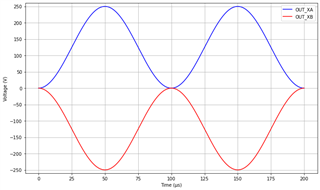Other Parts Discussed in Thread: ULC1001, ULC1001-DRV2911EVM
Tool/software:
Dear TI representative,
I am currently working with the ULC1001-DRV290XEVM, but I am not entirely certain how to interpret the output signal. The board indicates an output of 0–250 Vp. In the accompanying software, it is possible to set the “Amp puV” parameter. I assume that setting this value to 1 results in a 250 V peak differential signal between OUT_XA and OUT_XB. However, I would like to confirm: does this mean one output reaches +250 Vp and the other –250 Vp, creating a total differential of 500 Vp, or is the signal +125 Vp on one output and –125 Vp on the other, creating a total differential of 250 Vp? Another question, does the signal swing symmetrically around ground between the two outputs, or does one output remain at 0 Vp while the other reaches 250 Vp?
This information is important for my application, as I am using a piezo ring from Thorlabs (model PA44M3KW), which requires one side to be grounded. Would you consider it safe and appropriate to drive this piezo ring using the ULC1001-DRV290XEVM?
Thank you in advance for your time and support. If any part of my question requires clarification, I would be happy to elaborate.
Kind regards,
Hidde van de Rijke


